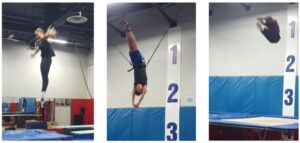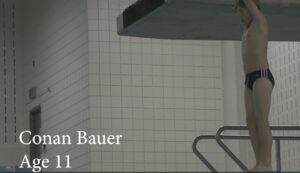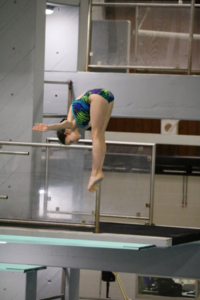Approach
Three or more steps forward to the end of the board before the hurdle and takeoff.
Armstand Dive
The diver executes a dive from an armstand position. The armstand takeoff represents a sixth group of dives used only in platform diving.
Back Dive
Takeoff from the end of the board with back toward water. Direction of rotation is away from the board.
Balk
An illegal movement by the diver: (1) a false start in which a diver makes an obvious attempt to start the approach but does not complete the dive; (2) takeoff for the hurdle from both feet; (3) Loss of balance on an armstand dive causing feet to touch the platform.
Degree of Difficulty
Rating ranging from 1.2 to 3.7 for executing a specific dive. The DD is multiplied by the sum of the judges’ scores in figuring the score for a dive.
Entry
The conclusion of a dive as a diver makes contact with the water. May be either head or feet-first. Upon entry, the body should always be near vertical in a straight position with toes pointed. In a headfirst entry, arms should be stretched above the head in line with the body and hands close together.
Flying
Used to describe a dive in which the diver assumes a straight position from take off, or after one somersault in a 115C, before executing the remainder of the dive. The straight position must be held for at least one quarter of a somersault (90 degrees).
Forward Dive
Takeoff from a standing or running approach, facing the water. Direction of rotation is away from the board.
Free Position
A combination of straight, pike or tuck positions. To be used in twisting dives only as listed in the DD tables.
Hurdle
The final segment of a diver’s approach to takeoff. Consists of a spring to the end of the board, taking off from one foot, and landing on two feet at the end of the board.
Inward Dive
Takeoff from a standing position at the end of the board, with back to the water. Direction of rotation is toward the board.
Judge
Diving official who scores each dive on a scale of 0 (lowest) to 10 (highest). Seven judges officiate major national and international competition in individual events. Nine judges officiate during synchro events.
Pike Position
A dive position in which the body is bent at the hips, legs straight at the knees, and toes pointed. Feet should be held together and position of arms is optional.
Platform
A stationary, non-bending diving platform is at least 20 feet long and six and a half feet wide. The platform height used in competition is 10 meters (approximately 33 feet). The platform structure typically also includes levels at three, five and seven and a half meters that are used during training.
Referee
Manages the competition and insures that all regulations are observed. Not a judge.
Reverse Dive
Takeoff from a standing or running approach, facing the water. Direction of rotation is toward the board.
Somersault
A movement in which a diver rotates the body on an imaginary horizontal axis through the hips. A dive that can be performed in a variety of combinations.
Springboard
An adjustable diving board that regulates “springiness.” Either 1-meter (3’3″) or 3-meters (9’9″) above the water. Projects at least five feet beyond the edge of the pool.
Straight Position
A dive position in which the body is straight without bending at knees or hips, feet together and toes pointed. Formerly called the “layout” position.
Takeoff
A diver’s lift from the board prior to execution of the dive. May be done from a forward (running or standing) or backward approach, or from an armstand position.
Tower
The entire diving platform structure.
Tuck Position
A dive position in which the body is bent at the waist and knees, with thighs drawn to the chest and feet kept close to the buttocks. Feet and knees should be kept together and toes should be pointed.
Twisting Dive
Any dive with a twist. There are four types of twisting dives: forward, back, reverse and inward.




